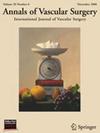Long-Term Outcomes of Open Surgical Repair for Complex Aortoiliac Occlusive Disease in the Age of Endovascular Advancements
IF 1.4
4区 医学
Q3 PERIPHERAL VASCULAR DISEASE
引用次数: 0
Abstract
Background
Aortoiliac occlusive disease (AIOD) may lead to critical limb ischemia, requiring revascularization. Open repair remains preferred for complex type C and D lesions despite endovascular options. This study evaluated long-term outcomes of open surgical repair in acute and chronic AIOD.
Methods
A single-centre, retrospective analysis was conducted on patients undergoing open AIOD repair (January 2010-December 2020). Primary outcomes included 30-day and long-term mortality; secondary outcomes were graft patency, Rutherford classification improvement, and limb salvage.
Results
Seventy-six patients (61% male; mean age 62 ± 10 years) underwent open repair for Trans-Atlantic Inter-Society Consensus (TASC) II type D AIOD. Peripheral arterial disease and prior interventions were common (67 patients, 88%). Elective surgery was performed in 49 patients (64%), while 27 patients (36%) underwent urgent procedures. The 30-day mortality rate was 0% (0/49) for elective cases but 19% (5/27) for urgent cases (P < 0.01). Long-term survival rates at 1, 2, 3, and 5 years were 98% (48/49), 96% (47/49), 94% (46/49), and 86% (42/49) for elective cases versus 78% (21/27), 62% (17/27), 62% (17/27), and 62% (17/27) for urgent cases (P = 0.30), respectively. Elective cases demonstrated high graft patency at 1, 2, 3, and 5 years (96% [47/49], 90% [44/49], 90% [44/49], and 85% [42/49]), respectively. Rutherford classification improved significantly (median preoperative stage 3 to postoperative stage 0, P < 0.001), with stable ankle-brachial index (ABI) values (≥0.9) in 59 of 61 patients (97%). Vascular complications occurred in 39 patients (51%), with reinterventions in 12 patients (16%). Sustained limb salvage was observed over long-term follow-up (median 59 months).
Conclusion
Open repair for complex AIOD offers durable outcomes, with low elective case mortality and high limb salvage and graft patency. Future studies should explore long-term comparative outcomes.
求助全文
约1分钟内获得全文
求助全文
来源期刊
CiteScore
3.00
自引率
13.30%
发文量
603
审稿时长
50 days
期刊介绍:
Annals of Vascular Surgery, published eight times a year, invites original manuscripts reporting clinical and experimental work in vascular surgery for peer review. Articles may be submitted for the following sections of the journal:
Clinical Research (reports of clinical series, new drug or medical device trials)
Basic Science Research (new investigations, experimental work)
Case Reports (reports on a limited series of patients)
General Reviews (scholarly review of the existing literature on a relevant topic)
Developments in Endovascular and Endoscopic Surgery
Selected Techniques (technical maneuvers)
Historical Notes (interesting vignettes from the early days of vascular surgery)
Editorials/Correspondence

 求助内容:
求助内容: 应助结果提醒方式:
应助结果提醒方式:


